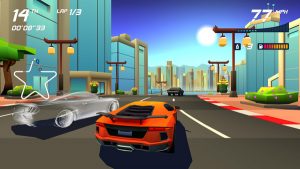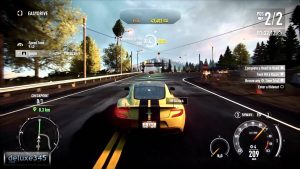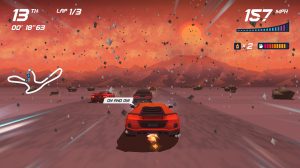Premise:
As per the Steam page: “Horizon Chase Turbo is a racing game inspired by the great hits of the 80’s and 90’s: Out Run, Lotus Turbo Challenge, Top Gear (SNES), Rush, among others.”

But what makes Horizon Chase Turbo (“HCT” for short) so captivating when its design appears so simple?
Concept:
Simplicity can be seen as both positive and negative, especially depending on one’s expectations and desires. However, in truth, I believe life is full of simple yet great moments: the taste of good food, the feeling of the sun shine or a cool breeze that hits just right, or even just a smile from someone you care about, can all seem “simple” yet still feel “good”.
In Horizon Chase Turbo, the main controls and mechanics for the game are relatively straightforward: you can accelerate, brake (but I can’t say I almost ever did when I played it), steer the car (e.g. to turn or avoid other cars), and boost, but the game remains fun and entertaining for many players where other games might feel “shallow”.
Elaboration:
So then how does HCT manage to be engaging? A game is, of course, not just its mechanics, but how they are used and “explored” through the level, map, or stage design. HCT starts rather simple, teaching you how to make basic and slower turns to navigate courses through its earlier tracks, and letting you feel out things like “so this is how fast I go when I boost” or “this is how much I have to hold the control stick to turn” for yourself.
For the track design, it can typically be divided into straights and curves. Straights are sections where your only maneuvering is to obtain tokens (which help unlock future levels), pick-ups (like nitro for boosting or fuel so your car can keep racing), and other cars, so they’re often a great chance to use your boosts you earned elsewhere without having that extra speed mess up your turns. Or maybe it’s just a chance to glance at the map and prepare for the next few turns you may have to make—a break in intensity that’s just short enough to refocus, but not so long you get bored of holding the accelerator.

Even in the later parts of the game, straights can be used to give the player a chance to boost and refocus for the next set of turns, and the limited amount of boosts per race helps creates a natural synergy between them and the track/its # of laps.
Meanwhile, turns are typically supplemented with objects on the side to help guide you, so even newer players can get a sense of where to turn without a lot of racing experience. However, in other racing games it can sometimes be hard to process the environment and where you’re turning, either because the excess of UI elements are distracting you, or more likely, the detailed environment means you need to process what’s in front of you more carefully.

Need for Speed Rivals. The game looks great, but there’s a lot more going on, and what looks like a path on the right might not actually be a valid path—especially when the lights on the ground and the car ahead aren’t pointing there. But whether it is or isn’t, processing little things in the environment that may or may not be important is extra information that could unintentionally distract or tire some players.
Another aspect of HCT that both “keeps it simple” and contributes to its accessibility is that there’s only a small penalty for messing up, at least in the earlier stages when you’re not expected to be a master of control yet.
Combine that with short laps that don’t overstay their welcome, and it results in an experience where the player can do a lap once and think “okay, I know where the tokens and pick-ups are, so let me try to get more of them this time!”. In fact, the races almost seem designed such that on the first lap, your main goal is to get used to the track and pass up at least half the other cars, then use the information you gathered to do better on the 2nd lap and collect more tokens or pick-ups, while finishing off strong in the 3rd or 4th lap. (Some races vary from this, but I believe a large majority of races fall within 3-4 laps.)
Of course, a single attempt at a track may not be enough get the placing one wants (or perhaps “needs”), but the key is that even as your controls are as simple as accelerating and turning, there’s plenty to engage with and pay attention to, and, at least in theory, the player is naturally motivated to do so. After all, the player starts with multiple boosts at the beginning, so if they see a boost item on the track, they already know the value of that item, which feeds back into the game by rewarding them with a speed increase that helps them do better.

That isn’t to say that HCT’s catchy, up-beat soundtrack and vibrant, whizzing-past-you visuals don’t contribute a TON to players’ enjoyment, because they do! (Or at least, they did for me!) But I think the game only stays interesting because it’s testing your steering with small, medium, and big adjustments, checking your ability to learn and adapt to layouts, and constantly leveling up your car and its speed/capabilities so that the game feels like it’s keeping up with your personal increase in skill.
The end-result? The game is “simple”, but it’s fun: you can’t fall asleep at the wheel, but it’s not requiring an esoteric understanding of physics, memorizing specific shortcuts that take notably precise maneuvers to access, or doing something weird like… making you need to look up the status effect of an RPG in the game’s internal glossary if you even want to know what it does.
Not that there’s anything inherently wrong with any of that, per se, but y’know—different types of fun, and simplicity is often the basis of one of the most accessible types of fun, as long as its done well enough to be simple, but not boring. That’s the beauty of it.